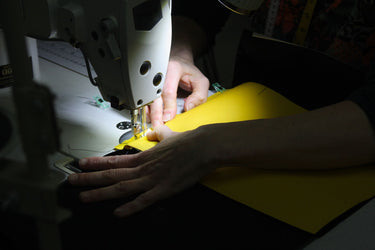SUSTAINABILITY
The most sustainable item is likely the item that is owned and used longest.
So, our north star is to make goods that can be loved deeply and used often for a very long time.
This starts by using the best materials we can find, and producing each bag with care.
Small batch production
The amount of waste in fashion — unsold products, unsaleable returned goods, lines that were cut, etc — is horrifying. (In 2018, a cornerstone luxury brand was discovered to have burned £28m worth of stock rather than have their name devalued.)
With an abhorrence for waste, we make only as many goods as are needed. Our limited runs and BYO are sold through a pre-order model, so that we only make as many goods as have homes; and our core collection is made in small batches that rarely change.
Local-first sourcing
When we look for materials we judge each item by it's quality, cost, sustainability and distance. More than 95% of the materials we use in each bag are sourced from mills here in the UK — specifically all canvas, webbing and our custom-milled G-hooks. It's not always possible to source in the UK as certain items simply are no longer made here (zips and trigger hooks, we're looking at you), but we're always on the hunt to source new suppliers closer to home. The smaller and more transparent we can keep the footprint of each item we make, the happier we'll be.
User-first design
We're plenty aware of the irony in wanting to help the environment by creating more products. So, before we begin creating anything, questions are asked. Surveys are sent out. Extensive observation and research occurs to make sure what we make fills a need that hasn't yet been met.
And then we obsess over the details and spend months sketching ideas. Multiple prototypes and samples are made, and tested, and refined again before going into production. And even then, surveys are sent to owners, so that we can continue to improve our designs.
We don't just want to make bags. We want to make the best possible bags — goods worth keeping forever.
Made in England
When we began, it was suggested that we ship the British canvas (that we wanted) to factories in China to make our bag, and then ship it back to the UK to be sold (and distributed) around the world. It was simply how companies could make the most money, and how the industry works. The transportation footprint of this horrified us, as did the lack of oversight, transparency and any connection to the seamsters.
Instead, we've chosen to keep all manufacturing in England. It's certainly not the easier path to profit.
But, by keeping it all close to home, we're able to guarantee the quality of materials, quality of production, quality of life for the skilled makers, and avoid an epic amount of unnecessary carbon emission.
Our team of samplers and machinists are all part of our local community and paid above the living wage.
GOTS-certified organic fabric and dye
Standard cotton is grown using pesticides and without any standard for oversight. Organic cotton requires that pesticides are fully avoided — thereby avoiding these dangerous chemicals from seeping into the water-stream and endangering the farmers and nearby communities. GOTS (Global Organic Textile Standard) oversees not just the adherence to chemical avoidance, but also ensures the welfare of workers.
100% of the canvas and dye we use in our CORE collection is GOTS-certified organic and fluorocarbon-free.
Fluorocarbon free (FCF)
Fluorocarbons are extremely persistent chemicals which are typically used for making materials water-resistant (raincoats, waterproof shoes and bags — yup, these probably have them). But what makes them effective also makes them horrific — they're 6x more potent to the environment than CO2 and incredibly difficult to breakdown (one statistic estimates their durability at around 50,000 years).
We're grateful that the Scottish and English mills we work with have developed highly effective, fluorocarbon-free alternatives. It's what we use, and we splash in puddles all the happier for it.
Reclaimed fabrics
The #1 least damaging material to the planet is the material that already exists. We are proud to offer limited runs of bags made from our own off-cuts, the off-cuts of other companies, and from discarded material and seconds-grade canvas we source wherever we can.
Vegetable-tanned leather
About 90% of leather in use today is 'chrome tanned'. It uses a process that produces pliable leather in less than a day. But this speed comes at a price — the chrome tanning process requires an enormous amount of chemically treated water to penetrate the leather, which results in a vast quantity of incredibly toxic waste water that is often unregulated and untreated.
Vegetable-tanned leather requires a far lengthier process — 30-60 days. But, with only natural items used to tan the leather, the water remains clean and the leather is able to safely biodegrade when its use is over.
We use very little leather in our products, but where we do, we always use veg-tanned leather. Whenever possible, we offer vegan alternatives in the form of webbing and canvas substitutes.



